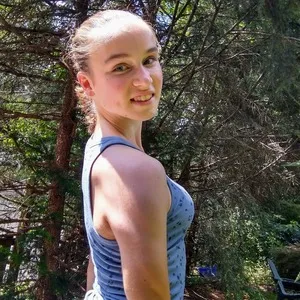Harley Langberg has made a career out of playing with food. But trust me, these are food faces that would impress even your mother. Harley shares his incredible food art pieces on his Instagram page @harleysfood_art. Fair warning, make sure you have at least 30 minutes free before you check it out, because you’re not going to be able to stop scrolling. From celebrities such as David Bowie (featuring turnips, red peppers, cucumbers, eggplants, and sun-dried tomatoes) to iconic film characters like Chewbacca (made from salmon dogs and caramelized onions), Harley has created thousands of incredibly detailed and strikingly realistic images from nearly every food imaginable over the past nine years. This Pride month, we interviewed Harley about his journey into food art, turning his passion into a career path, and why he has deep conversations with eggplant. Plus he shares his tips for creating colorful and delicious food art of your own to celebrate Pride month.
Spoon University: What inspired you to start creating food art?
Harley Langberg: About 9 years ago, when I was living in the meatpacking district of New York City, I saw a food art photography exhibit at Chelsea Market. I was amazed by this newly emerging form of art. I remember it was all these beautiful animals created out of fruits and vegetables. That night, I went back to the market and bought some ingredients, and I created my very first food art piece. I’ve always been into art and food, so it was a great combination of two of my passions.

SU: Food art isn’t something people typically think about, but there’s something so fascinating about it (I personally spent at least two hours scrolling through your Instagram page). Why do you think food art is so compelling to people?
HL: Food is universal, so even if you don’t know the character or celebrity, you might recognize the potatoes or cucumbers. I think that’s what gets people so excited, because it’s something we all eat, but you see it in a different form.
SU: What’s the most surprising thing about making food art?
HL: I’m always finding new ingredients that I haven’t worked with, and I’ve worked with a lot of ingredients. Especially going to international markets here in New York City. I went into this Japanese grocery the other day and I found dried anchovies! That’s what gets me excited because I’ve worked with almost every fruit or vegetable that exists, and it still surprises me that I can find some new ingredients I haven’t worked with. It’s also a great way to educate people on new ingredients that they could try in their cooking.
SU: What’s the most challenging aspect of making food art?
HL: Sometimes I have this great idea in my head, and it just doesn’t pan out, or a particular ingredient doesn’t want to work with me. I’ve had a lot of deep conversations with eggplant, trying to get it to listen to me. Sometimes it just wants to curl, and I don’t want it to curl! Or I think I’ve nailed a celebrity portrait, and my husband says “Who is that?” So, you know, that’s not encouraging. I’m constantly evolving and growing with food art, and I’m far from perfect, but it has been nice to see the evolution over the last nine years. When I first started it took so long, and I would get frustrated because I’m a bit of a perfectionist. But then I realized it’s just food. It can’t possibly be perfect, and you just have to have fun with it.
SU: It’s so inspiring how you found something you were passionate about and turned it into a career path. Do you have any advice for young people who are trying to build a career out of something they are passionate about?
HL: For me, it’s about the three P’s. You have to be proactive. If you’re passionate about something, opportunities aren’t just going to come to you, you have to put yourself out there. You have to be patient, because it does take time, and it could be frustrating, but it will come if you put in the work. And you have to be persistent. You may reach out to someone, and they say it’s not for me or don’t even respond, but you follow up and be persistent. So many times, I’ve done that and people have said I’m so glad you followed up because I didn’t get your first email, or I was busy, or whatever. I think those three P’s are so important when it comes to anything, not just food art, to be able to grow with it and take it to the next level.
SU: You have created some amazing pieces celebrating Pride month with food art. Why do you think it’s important to feature Pride in your food art?
HL: It’s another way to celebrate the month, just in a different format. It’s actually a very natural tie-in, because I work with all the different colors of food. Being able to create rainbow colored food art for Pride is really exciting. It’s a great way for me to educate some of my followers who may not be familiar with Pride, and it’s an opportunity for them to learn about it through my food art, and understand why it’s important that we have this month to celebrate.

SU: Do you have any tips for people who want to create their own food art to celebrate Pride?
HL: Have fun with it. If you’re creating food art for the first time, remember it doesn’t have to be perfect. It’s about having fun choosing ingredients and seeing what you can create on a plate. Don’t get caught up in details and perfectionism. Just have fun with it and choose ingredients you enjoy eating, because it’s always fun to create something and then eat it after.


